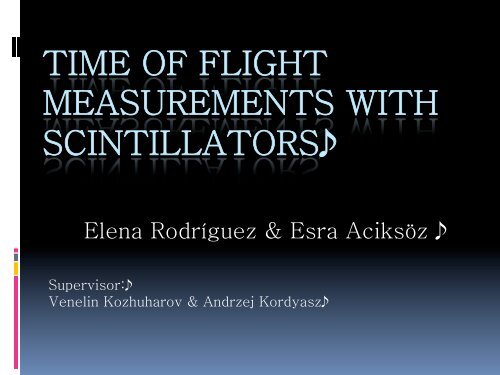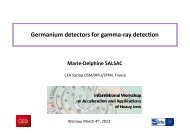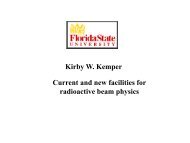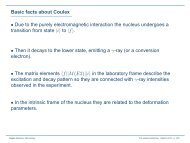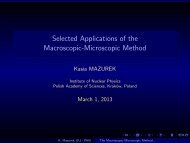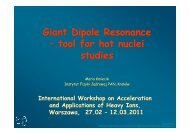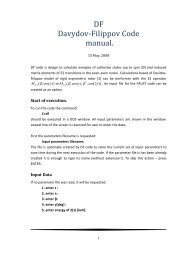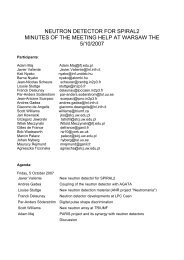TIME OF FLIGHT MEASUREMENTS WITH SCINTILLATORS
TIME OF FLIGHT MEASUREMENTS WITH SCINTILLATORS
TIME OF FLIGHT MEASUREMENTS WITH SCINTILLATORS
You also want an ePaper? Increase the reach of your titles
YUMPU automatically turns print PDFs into web optimized ePapers that Google loves.
<strong>TIME</strong> <strong>OF</strong> <strong>FLIGHT</strong><strong>MEASUREMENTS</strong> <strong>WITH</strong><strong>SCINTILLATORS</strong>Elena Rodríguez & Esra Aciksöz Supervisor:Venelin Kozhuharov & Andrzej Kordyasz
Contents § Introduction § Experiment with scintillators ú Plastic Scintillators ú Electronic (PMT, FC,TAC, ADC) ú Construction of the experiment ú Time Calibration ú Analysis and Results ú Velocity measurement ú Angular distribution ú Analysis and Results § Conclusions International Workshop on Acceleration and Applications of Heavy Ions 2
Introduction COSMICS RAYS § Muons (µ) § The muon is an unstable subatomic particle with a mean lifetime of 2.2 µs. § Mass of 105.7 MeV/c2, which is about 200 times the mass of an electron § Muons have a very large mass and energy compared with the decay energy of radioactivity, they are never produced by radioactive decay International Workshop on Acceleration and Applications of Heavy Ions 3
Experiments with Scintillators Plastic scintillators Scintillators are usually divided into three types, crystalline, liquid, and plastic, which utilize the ionization produced by charged particles to generate optical photons, typically in the blue to green wavelength regions. • Very short response times and are extensively utilized for experiments where accurate measurements of very short time intervals (ns) must be obtained in spite of extremely high counting rates • Detection of charged particles with minimal response to gamma-‐rays International Workshop on Acceleration and Applications of Heavy Ions 4
Photomultiplier (PMT) Multiply the charge produced by incident light (photoeffect) by as much as 100 million times Capable of resolving single photoelectrons of a light pulse produced by the scintillator International Workshop on Acceleration and Applications of Heavy Ions 5
Constant fraction discriminator (CFD) Is an electronic signal processing device, designed to mimic the mathematical operation of finding a maximum of a pulse by finding the zero of its slope Comparison of threshold triggering (left) and constant fraction triggering (right) International Workshop on Acceleration and Applications of Heavy Ions 6
Time to amplitude converter (TAC) Generates a rectangular output pulse whose peak amplitude is linearly proportional to the time interval between a START and STOP input pulse pair International Workshop on Acceleration and Applications of Heavy Ions 7
Analogic to Digital Converter (ADC) An analog-‐to-‐digital converter (ADC) is a device that converts a continuous quantity to a discrete time digital representation International Workshop on Acceleration and Applications of Heavy Ions 8
BASIC SCHEME <strong>OF</strong> CALIBRATION PULSE GENERATOR Start Stop TAC ADC FIXED DELAY PC We calibrate our setup by feeding it START and STOP pulses of known separations in time delays, measured by an osciloscope. A callibration is done at the beginning of the data taking International Workshop on Acceleration and Applications of Heavy Ions 9
Construction of the experiment 1. Assemble PMT 3. Cabling 2. Black tape 4. First signals J International Workshop on Acceleration and Applications of Heavy Ions 10
Construction of the experiment § Theory and Metod We determine the mean speed of muons by using two flat, broad scintillator pads separated by a vertical height, D. By placing concidence requirements on the signals from these detectors, we restrict our data to only those particles (muons) that have passed through both detectors, and find the time lag between the top and bottom events, T. We can then calculate the muon mean speed through the relationship, D= 83 ± 1 cm International Workshop on Acceleration and Applications of Heavy Ions 11
Time Calibration This calibration corresponds to a resolution of : -‐ Cable 1: 10,70 ± 0,5 ns -‐ Cable 2: 20,45 ± 1 ns -‐ Cable 3: 38,6 ± 2 ns -‐ One and two parameter linear fit checked K= constant fraction A= nº channel k= (0.0439 ± 0.0005) ns/channel International Workshop on Acceleration and Applications of Heavy Ions 12
Analysis and Results • Muons velocity Time is a function that depends on Δt1 and Δt2 We obtain the following equation Calibration according to obtain Velocity is a function that depends on the distance between detectors, Δt1 and Δt2 International Workshop on Acceleration and Applications of Heavy Ions 13
Analysis and Results C1/C2 C2/C1 Δt1 Δt2 International Workshop on Acceleration and Applications of Heavy Ions 14
Velocity measurement Effect Correction Error contribution [*10 8 m/s] Time 12 (stat) 0 0.036 Time 21 (stat) 0 0.055 External optical light (syst) 0 0 Scintillator area 0.08 0.08 Calibration 0 0.03 Distance uncertainty 0 0.031 Threshold value Included in sc. area 0 dT’ dT¨ > dT’ Muons velocity that we have obtained is: International Workshop on Acceleration and Applications of Heavy Ions 15
Angular distribution Events on each position of the detectors: Comments: -‐ Background position -‐ Last measurement 1 2 3 41 st position: -‐ Number of event s in the pick : 878 -‐ Total random events: 2036 2 nd position: -‐ Number of event s in the pick : 2979 -‐ Total random events: 12885 -‐ Number of backgrounds per bin: 10,49 -‐ Number of backgrounds per bin: 66,42 -‐ Total number of background events: 230,89 -‐ Total number of background events: 1461,2 -‐ 3Number rd position: of muon events: 647±30 -‐ 4Number th position: of muon events: 1517±56 -‐ Number of event s in the pick : 1010 -‐ Number of event s in the pick : 5621 -‐ Total random events: 4236 -‐ Total random events: 36468 -‐ Number of backgrounds per bin: 21,84 -‐ Number of backgrounds per bin: 188 -‐ Total number of background events: 480,37 -‐ Total number of background events: 4135,55 -‐ Number of muon events: 530±33 -‐ Number of muon events: 1485±78 International Workshop on Acceleration and Applications of Heavy Ions 16
Analysis and Results • Angular Distribution Muons impact our detectors from a whole distribution of directions defined by the spherical parameters . The distance traveled by any single muon between the detectors will be larger than their separation, D if is non-‐zero. Using the angular distribution of incident muon flux at a given elevation Where: International Workshop on Acceleration and Applications of Heavy Ions 17
Results Flux of single muon at zero degree azimuthal angle: 37± 5 µ / s/sr/m 2 Power of the angular spectrum: 7,8± 1,7 Cosmic ray broad shower This effect is independent on the different angles The amount of cosmic ray broad showers was obtained to be: 15% International Workshop on Acceleration and Applications of Heavy Ions 18
Conclusions • A PMT HV divider has been constructed • Two plastic scintillator counters were assembled • A data acquisition system was setup • The velocity of the muons was measured • The angular distribution was obtained • Few unexpected effects were observed International Workshop on Acceleration and Applications of Heavy Ions 19
Thank you for your attention!!! International Workshop on Acceleration and Applications of Heavy Ions 20


